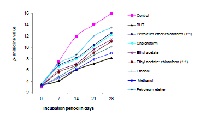Antioxidant, haemolytic activities and GC-MS profiling of Carissa carandas roots.
Keywords:
Antioxidants, corn oil, Carissa carandas, roots, lipidsAbstract
The antioxidant potential of the plant Carissa carandas roots extracted with different polarity based solvents was assessed. The antioxidant activity was evaluated by the measurement of total phenolic contents (TPC), total flavonoid contents (TFC), reducing power, DPPH radical scavenging, IC50 and antioxidant activity in linoleic acid system. The plant material contained the TPC (1.79-4.35 GAE mg/g of dry extract), TFC (1.91-3.76 CE mg/g of dry extract), DPPH radical scavenging activity, IC50 (12.53-84.82 %) and % inhibition of peroxidation in linoleic acid (41.0-89.21 %) system respectively. Furthermore the antioxidant effectiveness of extracts was assessed using corn oil (CO) as the oxidation substrate. The oxidative alterations were evaluated by the measurement of conjugated diene (CD), conjugated triene (CT), panisidine, free fatty acid (FFA) and peroxide values (PV). The cytotoxicity of the plant extracts were assessed against human red blood cells (RBCs) and the % lysis was found to be in the range of 1.01-6.10 %. The GC-MS analysis of n-hexane extract was also profiled. It was concluded that extracts of plant roots may be used as potential source of antioxidant agents in food industries.
References
Khare CP. Indian Medicinal Plants (an
Illustrated Dictionary), Springer Science,
New York, USA; 2007. 123,472.
Sathish CJ, Sharma RA, Jain R, Macalo N,
Capasso F, Vijayvergia R and Mittal C.
Ethno pharmacological evaluation of
Pergularia daemia (Forsk.) Chivo.
Phytotherapy Res. 1998; 12:378-380.
Anjaneyulu ASN, Raju DVSN, Srinivasa
Rao S. chemical evaluation of pergularia
daemia. Indian J. of Chem. 1998;
B:318-320.
Bhaskar VH, Balakrishnan N.
Hepatoprotective activity of laticiferous
plant species Pergularia daemia and
Carissa Carandas from Western Ghats,
Tamilnadu, India. An International Peer
Reviewed. J. of Pharm. Sci. 2009; 1(2):
-142.
Chatterjee ML, Roy AR. Pharmacological
action of Carissa carandas root. Bulletin
of the Calcutta School of Tropical Medi.
; 13(1):14-16.
Joglekar, SN, Gaitonde, BB. Histamine
releasing activity of Carissa Carandas
roots (Apocynaceae). Japanese of J. of
Pharmacol. 1970; 20:367.
Zaki A, Tohamy S, Fattah S. Study of
Lipid content and volatile oil of the
different organs of Carissa Carnadas Linn.
And Carissa grandiflora Dc. growing in
Egypt. Egyptian J. of Pharma. Sci. 1983;
(1-4):127-141.
Sharma alok, Reddy GD, Kaushik Atul K,
Shankar, Tiwri RK, Alok Mukherjee, Rao
ChV. Nat. Prod. Sci. 2007; 13(1): 6-10.
Mala V, Dahot MU. Lipase activity of
Carissa carandas fruits. Science
International-Lahore. 1995; 7(2): 161-164.
Chandra G. Essential Oil of Carissa
carandas. Examination of the benzene
extract of the flowers and of the essential
oil. Soap, Perfum. and Cosmet. 1972; 45
(6): 551-556.
Naim Z, Khan M, Nizami S. Isolation of a
new triterpenic alcohol from of Carissa
carandas. Pakistan J. of Sci. and Indus.
Res. 1985; 28(6): 378-381.
Pal R, kulshreshtha DK, Rastogi RP. A
new lignan from Carissa carandas.
Phytochemistry 1975; 14(10): 2302-2303.
Pino J , Marbot R, Vazques C. Volatile
flavor constituents of Karanda (Carissa
carandas L.) fruit. J. of Esse. Oil Res.
; 16(5): 432-434.
Siddiqui S, Ghani U, Ali S, Usmani S,
Begum S. Triterpenoidal Constituents of
the leaves of Carissa carandas. Nat. Prod.
Sci. 2003; 31(11):753-755.
Sarin Y, Kapoor L. Vegetable tannin
recourses of Jammu and Kashmir. Bulletin
of the Reg. Res. Lab. – Jammu. 1963;
:136-141.
Naim Z, Khan M, Nizami S. Isolation of a
new isomer of ursolic acid from fruits and
leaves of Carissa carandas. Pakistan J. of
Sci. and Indus. Res. 1988; 31(11): 753-
Edeoga HO, Okwu DE, Mbaebie BO.
Phytochemical constituents of some
Nigerian medicinal plants. African J. of
Biotec. 2005; 4(7): 685-688.
Chaovanalikit A and Wrolstad RE. Total
anthocyanins and total phenolics of fresh and
processed cherries and their antioxidant
properties. Food Chem. And Toxicol. 2004;
:67-72.
Dewanto V, Wu X, Adom KK and Liu RH.
Thermal processing enhances the nutritional
value of tomatoes by increasing total
antioxidant activity. J. of Agri. and Food
Chem. 2002; 50:3010–3014.
Bozin B, Mimica-Dukie N, Simin N, and
Anackov G. Characterization of the volatile
composition of essential oil of some
lamiaceae species and the antimicrobial and
antioxidant activities of the entire oils. J. of
Agri. and Food Chem. 2006; 54:1822-1828.
Iqbal S, Bhanger MI and Anwar F.
Antioxidant properties and components of
some commercially available varieties of
rice bran in Pakistan. Food Chem.2007;
:265-272.
Yen GC, Duh PD and Chuang YD.
Antioxidant activity of anthraquinones and
anthrone. Food Chem. 2000; 70:307–315.
Powell WA, Catranis CM, Maynard CA.
Design of self processing antimicrobial
peptides for plant protection. Letters in
Applied Micro. 2000; 31:163-168.
Anwar F, Bhanger MI Iqbal S. Long term
antioxidant activity guided evaluation of
Soft fruits and extracts in Synthetic
antioxidant in Soybean oil J. of Japan Oil
Chemist Soc. 2003; 12(2): 18-20.
American Oil Chemists Society. Official
and Recommended Practices of the
American Oil Chemists Society, 5th ed.,
USA: AOCS Press Champaign IL. 1997.
Sultana B, Anwar F, Asi MR, Chatha SA.
Antioxidant potential of extract from
different agro wastes: stabilization of corn
oil. Grasas y aceites. 2008; 59(3):205-217.
International Union of Pure and Applied
Chemistry (IUPAC). Standard Methods for
the Analysis of Oils, Fats and Derivatives,
th Rev. edited by C. Paquot and A.
Hautfenne, Blackwell Scientific, London.
Orishadipe AT, Okogun JI, Mishelia E.
Gass chromatography-mass spectrometry
analysis of the hexane extract of
Calliandra portoricensis and
itsantimicrobial activity. African J. of Pure
and Applied chem. 2010; 4:131-134.
Nazifi E, Delazar A, Movafeghi A,
Hemmati S, Nazemiyeh H, Nahar L,
Sarker SD. GC-MS of the dichloromethane
extract of the bulbs of Ornihogalum
cuspidatum Bert. (Family: Liliaceae) from
Iran. Record of Nat. Prod. 2008; 2:94-99.
Hedge K, Thakker SP, Joshi AB, Shastry
CS, Chandrashekhar KS. Anticonvulsant
activity of Carissa Carandas Linn. Root
extract in experimental mice. Tropical J. of
pharma. Res. 2009; 8(2):117-125.
Bhaskar VH, Balakrishnan N. Analgesic,
anti-inflamatory and antipyretic activities
of Pergularia deamia and Carissa
Carandas. Daru. 2009; 17(3):168-174.



